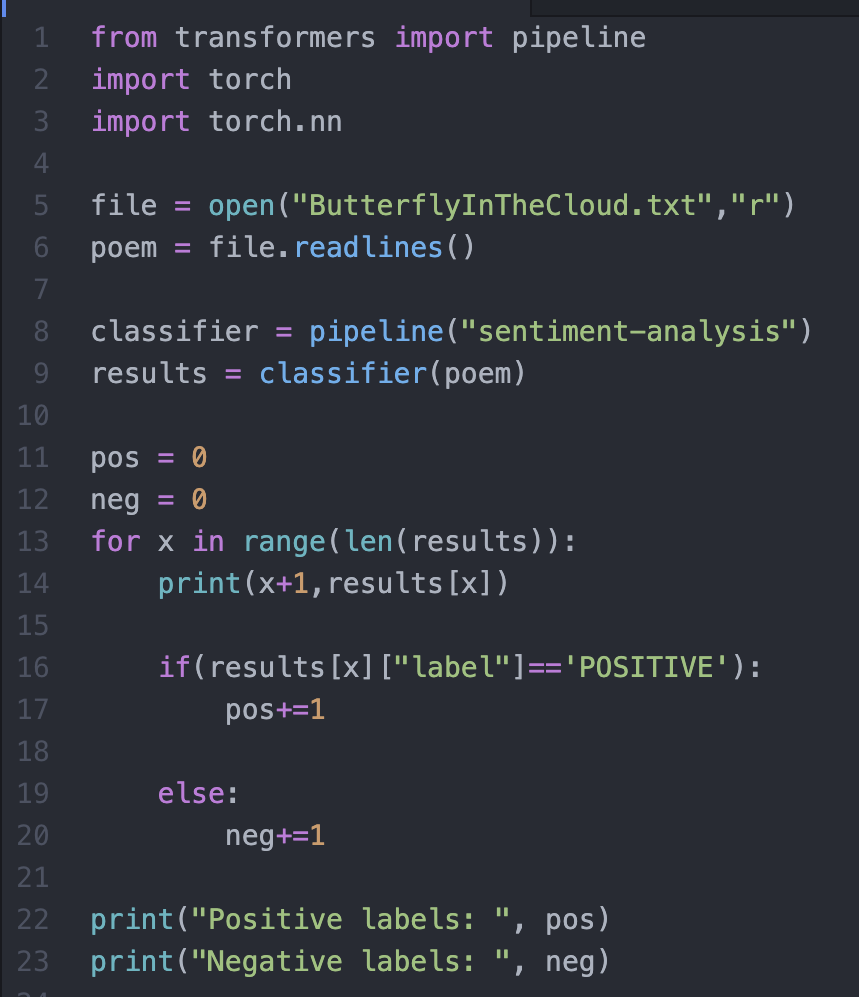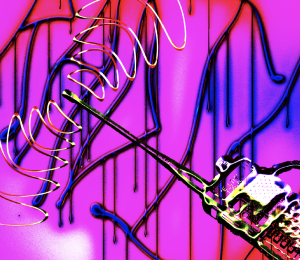C, B, A—the first three notes of Eryk Salvaggio’s A Butterfly in the Cloud (2021) descend, setting a melancholic tone. Shifting imagery of delicate butterflies frames bold white text, which is read aloud in an accented text-to-speech voice. The result is something both natural and mechanical. Salvaggio, bridging his interests of artmaking and technology, used artificial intelligence and machine learning to generate both the text and music. These words were based on, in his words, “gentler” texts, like feminist theory and cybernetics texts. The video format of the piece gives viewers an experience built from various components—the soundscape, narration, and imagery. I was curious, most of the piece having been born out of machine learning models, how a basic trained model would react to just the text. Without the wistful music behind the words being read aloud, I don’t think my experience of reading the text to myself would have felt the same. But a computer cannot have this same multifaceted experience, so I thought about how it would react to the isolated text and performed sentiment analysis—a machine learning task—on a transcription of the video.
🤗 (Hugging Face) is a domain containing a variety of libraries and datasets designed for Natural Language Processing (NLP) machine learning tasks. By using one of 🤗’s pipelines—simplified code that can be used to quickly and easily perform machine learning tasks—I could see the model’s decisions about whether each line of the song lyrics was positive or negative. See below for a screenshot of the code I wrote. The pipeline makes training a machine super simple—the task was streamlined to be only two lines of code (see lines 8 and 9). The rest of the code was simply for data preparation and organizing the output.

The results show, of 35 lines of text, that 18 were positive and 17 were negative. It is interesting that there is an almost 50/50 divide. Of the lines that read positive, there seems to be a common theme of lighter, nature focused imagery. The opening line, “The butterflies in this data center are not simply colorful and aromatic” as well as the line, “The butterflies are the most delicate of all” produced very high scores for being positive, meaning that the program has high confidence in this answer. On the other hand, computer focused imagery, such as “They are hardwired into the servers, the routers, the hubs and the switches” and “The USB drives are their antennae” produced confident scores for negative. Software engineers and computer science researchers may be the people training these models, but they are not necessarily writing the source text. Salvaggio mentioned that he specifically selected “gentler” texts because often other models would be harsher and more problematic due to source material from everywhere and anywhere across the World Wide Web. If this text can come from anyone from a scholar to an online troll, what does this then say about general human feelings towards technology? Yes, this data was produced by a computer, but all the words the computer knows and trained with, were written by us, the users.
Butterflies are often a beautiful symbol of metamorphosis but feel mysterious in this context. It brings up some of the same reactions that a watching sci-fi film might—this uneasiness that what you’re viewing is fiction, but that there is some degree of possibility of it becoming reality. The butterfly becomes such a perfect symbol because of its metamorphosis. We can compare its change to that of the change in the world because of technological advancements. The smart phones and social media we use every day was unthinkable to people of years before, but putting ourselves in their shoes, considering the exponential growth we’ve seen in tech, it’s hard to imagine what’s to come. Yet, there is something inappropriate about the phrase “the USB drives are their antennae,” when most technology and computer science concepts were modeled after what is already observed in nature. The comparison is backwards. There is nothing inevitable about the advancements we have been able to make regarding technology, but we are able to continue simply because our environment’s natural genius allows us to apply similar concepts through tech in a previously inconceivable way. Things like neural networks were possible because their structure mirrors the way the neurons in our brains function, so they were aptly named. The negative reaction to technology-focused verbiage simply reflects that our comparative perspective on natural, environmental objects versus computers and machinery is much fonder and more accepting. Despite how seamlessly technology has been integrated into our lives, there is still a looming fear of the unknown associated with artificial intelligence and “smart” machinery.
Next time you open your computer or smartphone, I urge you to take a second to reflect on how much technology has impacted your life. If we don’t separate ourselves from technology, we too, like the butterflies in the clouds, will become “hardwired into the servers, the routers, the hubs, and the switches,” becoming controlled by the very things we created to improve our lives.
:::

Jenna Donaldson is a sophomore at the University of Richmond studying Computer Science, Visual Arts, and Japanese. She is passionate about learning languages and creating things. In her free time she currently loves crocheting, listening to music, and dancing.



